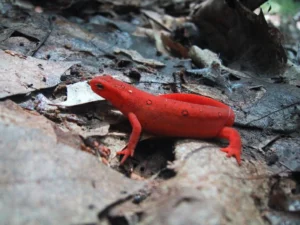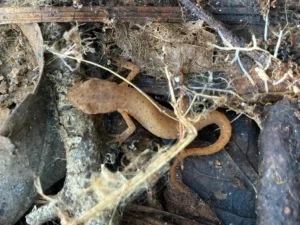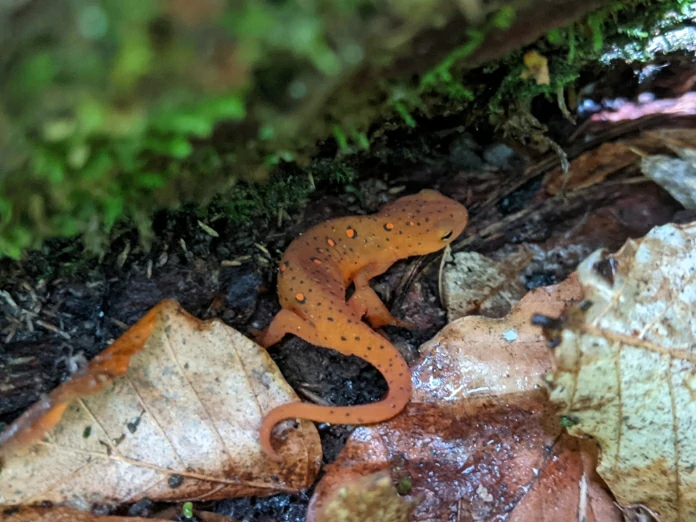You’re sitting in your living room when your curious cat suddenly pounces on something tiny near the window. It’s a small, wiggly newt that somehow got inside. You freeze and wonder: could this little creature be dangerous to your cat ?
Yes, some newts are poisonous to cats, but it depends on the species and how much your cat comes into contact with it. Most newts produce toxins that can make cats sick if swallowed or licked, though a quick sniff or paw swipe usually won’t cause serious harm.
Which Newt Species Are Most Poisonous?
Not all newts are the same. Some have mild toxins, while others carry chemicals strong enough to upset a cat’s stomach.
For example, rough-skinned newts are famous for having one of the most powerful toxins among amphibians.

Even a small amount can be harmful if eaten.
Most other garden or pond newts, like smooth newts or Eastern newts, produce milder toxins.

These toxins usually keep birds, snakes, or other predators away, but cats aren’t immune.
Their curious tongues and paws can spread the poison if they touch or lick the newt.
It’s actually pretty interesting: the toxins come from the skin, so even touching a newt is enough to expose your cat.
Cats with sensitive stomachs might react more strongly, but severe cases happen mostly with the really toxic species.
How Newts Use Toxins to Protect Themselves
Newts aren’t trying to scare anything, they’re just trying to survive. Bright colors, like orange or red, are a warning sign for predators.
This is called aposematism, basically nature’s way of saying, “I taste bad, don’t eat me.”

When a cat comes across a newt, it might paw at it, sniff it, or even lick it. The newt’s skin chemicals are enough to make a cat gag, drool, or get an upset stomach.
The toxin can irritate the mouth, tongue, or throat, so cats usually learn fast to avoid these little creatures.
For example, if a cat in your garden bats at a small Eastern newt, it might spit it out right away and back off.
This is the newt’s clever survival trick in action, it rarely needs to bite or sting to protect itself.
What Happens if a Cat Eats a Newt?
If your cat actually swallows a newt, things can get more serious. Symptoms often appear within minutes to hours and may include:
-
Drooling or foaming at the mouth
-
Vomiting or gagging
-
Diarrhea
-
Weakness or tiredness
-
Tremors in severe cases
In rare cases, especially with highly toxic species like rough-skinned newts, eating one can be dangerous enough to affect a cat’s heart or breathing.
That’s why immediate veterinary care is important if you think your cat ate a newt.
Cats are naturally curious, and they don’t always know what’s safe. Even a small nibble can introduce enough toxins to make them sick, so it’s best not to take chances.
How Cats Typically Come Across Newts
Most cats aren’t likely to hunt newts indoors, but outdoor explorers are a different story. Cats love damp, shady spots, which just happen to be newt-friendly.
Garden ponds, wet leaves, and logs are perfect hiding places for these amphibians.
Imagine your cat slipping quietly under a bush near a pond. It might notice a bright orange Eastern newt moving slowly along a wet rock.

The cat’s hunting instincts kick in. It swipes, paws, and sniffs, but that’s exactly when the newt’s skin toxins come into play.
Even if your cat doesn’t eat the newt, toxins can get on its paws, fur, or mouth.
Later, when your cat grooms itself, the chemicals spread, potentially causing irritation or mild poisoning.
Are Indoor Cats Safe from Newt Poisoning?
For most indoor cats, newts aren’t a big threat. Newts rarely make it inside, and the chances of an indoor cat finding one are low.
Still, accidents happen. A newt that sneaks in from a damp window sill or indoor pond can pose a real risk if the cat investigates.
It’s a good idea to check any indoor water features or terrariums where newts are kept.
Even harmless species can still cause mild irritation if touched. Keeping cats away from these areas usually keeps them safe.
Can a Cat Die from Newt Poisoning?
Most newt encounters cause only mild reactions, but some species are strong enough to be fatal, especially if eaten.
Rough-skinned newts, for instance, produce tetrodotoxin, the same chemical found in pufferfish. This toxin can stop the heart or breathing in high doses.
Fatal cases are very rare. Most outdoor cats only get mild to moderate poisoning unless they actually eat the newt.
Still, any exposure should be taken seriously. Quick veterinary help is the safest approach.
What to Do if Your Cat Touches or Eats a Newt
If your cat only touches a newt, you should:
-
Wash your cat’s paws, face, and any fur that contacted the newt with mild soap and warm water.
-
Watch for signs like drooling, vomiting, or unusual tiredness.
If your cat eats a newt:
-
Call your vet right away. Describe the newt species if you can.
-
Don’t make your cat vomit unless your vet tells you to. Some toxins make vomiting more dangerous.
-
Keep your cat calm and hydrated until you can get professional help.
Cats are tough, but newts can be surprisingly strong. Quick action usually makes all the difference.
How to Prevent Your Cat from Contact with Newts
Prevention is always better than treatment. Here are some practical tips:
-
Keep cats indoors during dawn and dusk when newts are most active.
-
Block access to garden ponds or wet areas with fencing or plant barriers.
-
Remove logs, rocks, or dense foliage where newts like to hide.
-
Supervise outdoor playtime, especially for cats that like damp spots.
You don’t have to turn your garden into a fortress. Just knowing where newts hide and watching your cat closely can prevent most accidents.
Why Newts Don’t Usually Attack Cats
Newts aren’t aggressive, they don’t hunt, bite, or chase cats. Their defense is passive, based on toxins and warning colors.
They hope predators notice their bright skin and learn not to eat them.
This actually works well in nature. Birds, frogs, and snakes quickly learn that a newt tastes bad or makes them sick.
Cats, being curious but careful, often get the same lesson without serious harm, as long as they don’t swallow the newt.
It’s kind of amazing to watch. A cat might paw at a newt, sniff it, then back away, basically learning nature’s warning signs in real-time.
Can Humans Be Poisoned by Newts Too?
It’s not just cats, humans can be affected by newt toxins too. Skin contact usually causes mild irritation, and touching your eyes or mouth can make it worse.
Handling newts carefully and washing hands afterwards is always smart.
This is the reason why cats are more vulnerable: they lick themselves often, spreading any toxins across their mouth and fur.
What’s mild for a human can be more serious for a cat.
Why Some Cats Seem Unaffected
You might see some cats play with newts and not get sick. This can happen because:
-
The newt species is only mildly toxic
-
The cat only touched it briefly and didn’t ingest much toxin
-
Cats’ grooming habits vary, so toxins aren’t always spread efficiently
Still, even if your cat seems fine, repeated encounters or a different species could be riskier. Treat all newts as potentially harmful.
Conclusion
Newts are interesting little creatures, and their toxins are a clever way to protect themselves.
For cats, they can cause mild to serious poisoning, depending on the species and exposure.
Most encounters are harmless if the cat only touches the newt, but eating one is risky.
Quick action, careful observation, and prevention are key to keeping your cat safe.
Hi, my name is Ezra Mushala, i have been interested animals all my life. I am the main author and editor here at snakeinformer.com.

